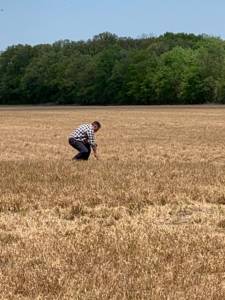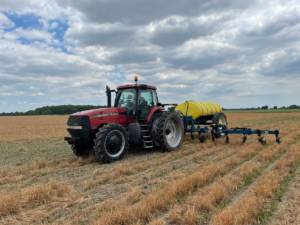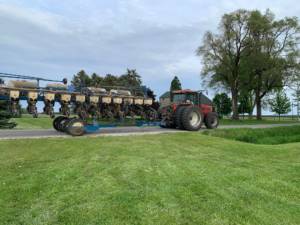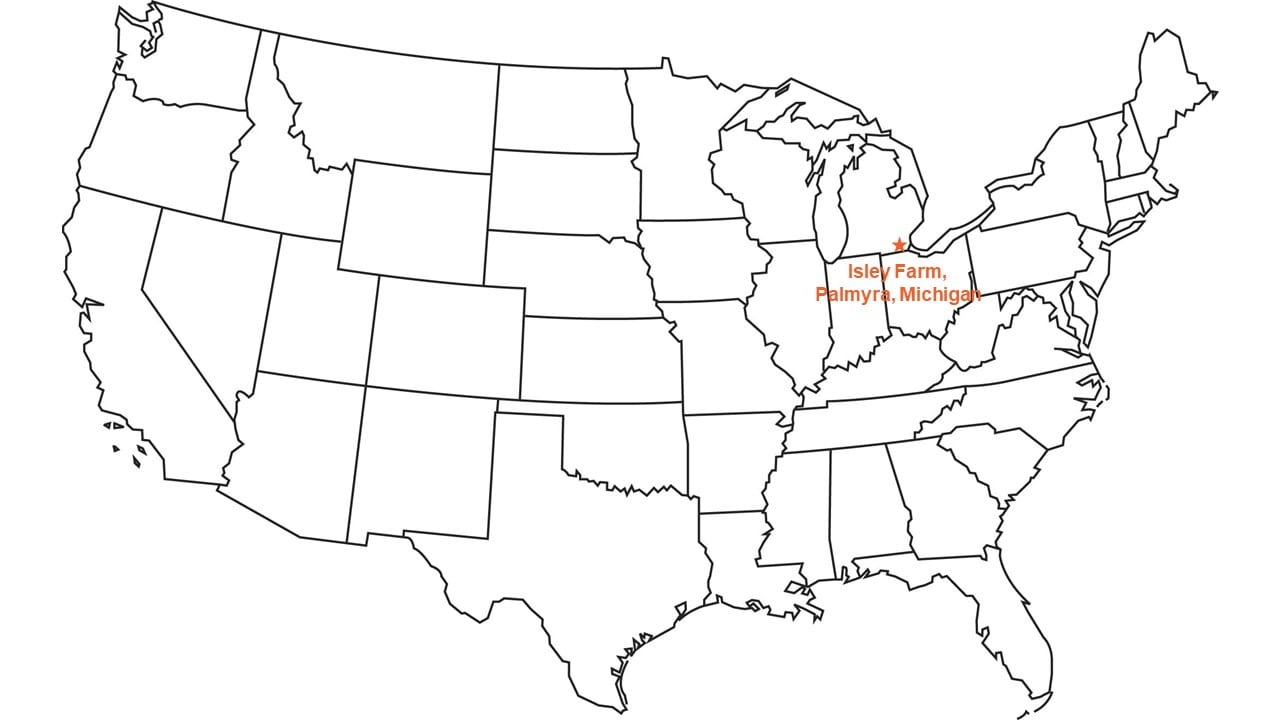We finished planting soybeans in mid-May, and we terminated all our cover crops prior to crop emergence. Corn planting was completed on May 24. It required lots of early mornings and late nights. We are thankful to have all our crops in the ground.
 We plant soybeans before corn because we have seen yield increase and they handle changing weather conditions better, and that has been the case this year, too. Although soil temperatures were cool when we started, those soybeans waited a couple weeks for warmer conditions before germinating and emerging. Although many of our soybeans emerged slowly, they are now growing well. Our corn is also fully emerged.
We plant soybeans before corn because we have seen yield increase and they handle changing weather conditions better, and that has been the case this year, too. Although soil temperatures were cool when we started, those soybeans waited a couple weeks for warmer conditions before germinating and emerging. Although many of our soybeans emerged slowly, they are now growing well. Our corn is also fully emerged.
Another reason we start by planting soybeans is that we share our planter with another farmer. Our soils are lighter, or sandier, than his, so ours usually dry out sooner than his. When we finish planting, the timing usually works well for him to start planting his soybeans. Sharing equipment allows all of us to get more value from it, and it encourages our neighbor to practice conservation.
We highly value the precision technology that allows us to vary seeding and fertilizer rates based on soil tests. But, we do have to keep this technology working smoothly. Equipment malfunctions caused some planting delays this year, but we believe using the technology is worth unexpected equipment delays. But when we put in those long days and the weather and equipment cooperate, we can plant about 60 hectares, or 150 acres a day. Usually my son Jake runs the planter, while my husband Jim runs the sprayer. I pick up parts when needed and help when we move the equipment from one field to another.
 Once the corn is planted, we apply liquid nitrogen to help it get a good start. Then, in a few weeks we will start scouting fields for weed pressure. We usually apply herbicides at least once in both our soybeans and corn a few weeks after the burndown herbicide done during planting. However, we want to choose the best herbicide option for the weed pressure and apply it only where needed. We have some herbicide-resistant weeds in our fields. By scouting and knowing what weeds are present, we can make better decisions to use different herbicide modes of action. That prevents existing resistance from spreading and new resistance from developing, all while protecting crop yield and quality.
Once the corn is planted, we apply liquid nitrogen to help it get a good start. Then, in a few weeks we will start scouting fields for weed pressure. We usually apply herbicides at least once in both our soybeans and corn a few weeks after the burndown herbicide done during planting. However, we want to choose the best herbicide option for the weed pressure and apply it only where needed. We have some herbicide-resistant weeds in our fields. By scouting and knowing what weeds are present, we can make better decisions to use different herbicide modes of action. That prevents existing resistance from spreading and new resistance from developing, all while protecting crop yield and quality.
We consistently monitor the market prices for our crops. We are making decisions now about selling some of the crop we just planted. We gather information from a variety of sources, including our local grain buyer, to understand the factors influencing prices. Understanding these factors helps us find a balance between selling some of the crop to ensure a profit, but not selling too much, since we don’t yet know how much we will produce this year.
 The factors that can influence prices range from supply and trade issues to logistics. For example, a few weeks ago, a crack in a bridge across the Mississippi River in Memphis, Tennessee, about 1,125 km, or 700 miles, away from us stopped barges carrying soybeans from the Midwest to the Gulf of Mexico for a few days. While prices for farmers south of that point increased briefly, our soybean prices temporarily fell. Thankfully, this was a short-term challenge, and we quickly resumed normal soybean shipping. But we noticed its impact.
The factors that can influence prices range from supply and trade issues to logistics. For example, a few weeks ago, a crack in a bridge across the Mississippi River in Memphis, Tennessee, about 1,125 km, or 700 miles, away from us stopped barges carrying soybeans from the Midwest to the Gulf of Mexico for a few days. While prices for farmers south of that point increased briefly, our soybean prices temporarily fell. Thankfully, this was a short-term challenge, and we quickly resumed normal soybean shipping. But we noticed its impact.
That is just one example of the uncertainty we manage while raising our crops. We adapt to both the changing weather and markets, while still doing what is best for our soil, water and crop quality.

